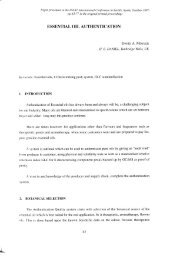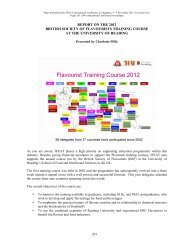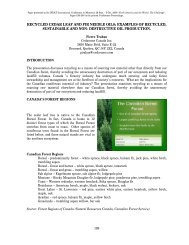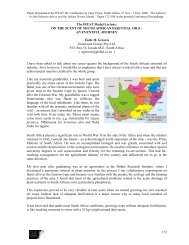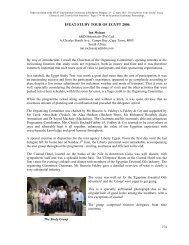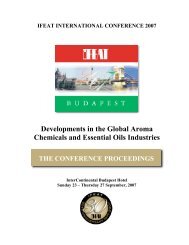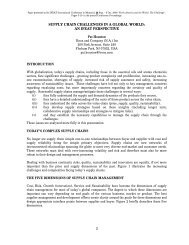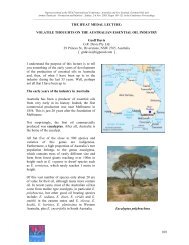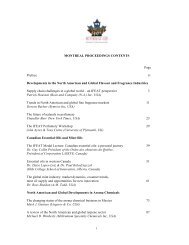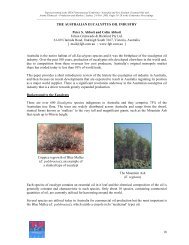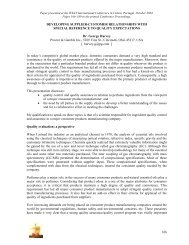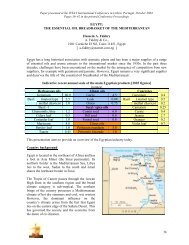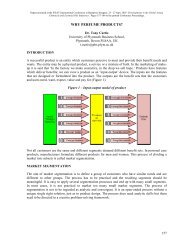extracts” <strong>in</strong> <strong>the</strong> South African harmonized tariff code system, however, does make <strong>the</strong> estim<strong>at</strong>ion of<strong>the</strong> total production an <strong>in</strong>accur<strong>at</strong>e exercise.)Estim<strong>at</strong>ed production of buchu oil2003 2006 2008(predicted)tonnes 3.5 5 7.5Currently, A. crenul<strong>at</strong>a and hybrid / blended oils still account for ca. 35% of sales. However, thisproportion will progressively decrease along with selective new plant<strong>in</strong>g of A. betul<strong>in</strong>a.With <strong>the</strong> decrease <strong>in</strong> popularity of A. crenul<strong>at</strong>a oil, a surplus of cultiv<strong>at</strong>ed A. crenul<strong>at</strong>a plant m<strong>at</strong>erialis already experienced and it has caused <strong>the</strong> price of this oil to plummet <strong>in</strong> <strong>the</strong> past 3 years.Currently A. crenul<strong>at</strong>a oil is viewed as a n<strong>at</strong>ural source for buchu’s unique cis/trans-8-mercapto-pmenthan-3-oneand cis/trans-8-acetylthio-p-menthan-3-one isomers. Production of a ‘buchu sulphurfraction’ <strong>in</strong> which <strong>the</strong> pulegone level is, rel<strong>at</strong>ive to <strong>the</strong> levels of <strong>the</strong> flavour contribut<strong>in</strong>g sulphurcompounds, equally low as it is <strong>in</strong> A. betul<strong>in</strong>a oil has been developed <strong>in</strong> South Africa and s<strong>in</strong>ce 2004this speciality fraction of buchu oil has been commercially available.In order to limit poach<strong>in</strong>g of wild buchu plant m<strong>at</strong>erial from <strong>the</strong> wild, its cultiv<strong>at</strong>ion, harvest<strong>in</strong>g (from<strong>the</strong> wild especially), and process<strong>in</strong>g is carefully monitored by <strong>the</strong> governmental <strong>Cape</strong> N<strong>at</strong>ureConserv<strong>at</strong>ion Group. In spite of measures to comb<strong>at</strong> poach<strong>in</strong>g and <strong>the</strong>ft of buchu plant m<strong>at</strong>erial, it wasa common occurrence, ma<strong>in</strong>ly as a result of unscrupulous distillers who purchased poached / stolenm<strong>at</strong>erial, thus effectively encourag<strong>in</strong>g <strong>the</strong> depletion of <strong>the</strong> wild buchu stock. With <strong>the</strong> recent emphasison mass cultiv<strong>at</strong>ion of buchu as opposed to harvest<strong>in</strong>g from <strong>the</strong> wild <strong>the</strong> needs of <strong>the</strong> buchu market are<strong>in</strong>creas<strong>in</strong>gly met by cultiv<strong>at</strong>ed m<strong>at</strong>erial, <strong>the</strong>reby decreas<strong>in</strong>g <strong>the</strong> prevalence of poach<strong>in</strong>g of wild plantm<strong>at</strong>erial and <strong>the</strong>reby preserv<strong>in</strong>g <strong>the</strong> surviv<strong>in</strong>g wild popul<strong>at</strong>ion.Feedstock sourc<strong>in</strong>g: plant<strong>at</strong>ions versus wild harvest<strong>in</strong>g (est.)2003 season sourc<strong>in</strong>g 2006 season sourc<strong>in</strong>gSpecies From <strong>the</strong> wild From plant<strong>at</strong>ions From <strong>the</strong> wild From plant<strong>at</strong>ionsA. betul<strong>in</strong>a 30% 70% 15% 85%A. crenul<strong>at</strong>a 10% 90% - 100%Hybrib - 100% - 100%Formal cultiv<strong>at</strong>ion of buchu, however, br<strong>in</strong>gs ano<strong>the</strong>r factor affect<strong>in</strong>g buchu oil quality <strong>in</strong>to play,namely agricultural residues. In areas where A. betul<strong>in</strong>a buchu is found n<strong>at</strong>urally (Piketberg/Citrusdal)agricultural residues are not a gre<strong>at</strong> concern. Buchu has few n<strong>at</strong>ural pests <strong>in</strong> <strong>the</strong>se areas and performswell unaided by any pesticides / acaracides when cultiv<strong>at</strong>ed from seedl<strong>in</strong>gs. However, when buchu ispropag<strong>at</strong>ed veget<strong>at</strong>ively, as has been recently developed, or is cultiv<strong>at</strong>ed under hydroponic conditions,or even when it is cultiv<strong>at</strong>ed <strong>in</strong> areas far outside of its n<strong>at</strong>ural range, it is far more sensitive to <strong>at</strong>tacksfrom pests and diseases. As no pesticides / acaracides have been officially approved for use on buchuplant m<strong>at</strong>erial, its spray<strong>in</strong>g is technically illegal. However, <strong>the</strong>re is no doubt th<strong>at</strong> producers spray <strong>the</strong>irplants when under thre<strong>at</strong> to protect <strong>the</strong>ir sizeable <strong>in</strong>vestment.Buchu oil distillers th<strong>at</strong> are HACCP certified conduct, as part of <strong>the</strong>ir HACCP procedures, rout<strong>in</strong>eanalysis for pesticide / acaracide contam<strong>in</strong><strong>at</strong>ion <strong>in</strong> buchu oils. EU legisl<strong>at</strong>ion outlaw<strong>in</strong>g <strong>the</strong> sourc<strong>in</strong>g offlavour and fragrance <strong>in</strong>gredients from suppliers th<strong>at</strong> are not HACCP accredited has thus far led to <strong>the</strong>107
HACCP certific<strong>at</strong>ion of only two of <strong>the</strong> eight companies th<strong>at</strong> are known to produce buchu oilregularly.The Future of <strong>the</strong> Industry – challenges and opportunitiesFrom a buchu oil production po<strong>in</strong>t of view, especially <strong>the</strong> observed and fur<strong>the</strong>r expected growth <strong>in</strong>available plant m<strong>at</strong>erial volumes – as well as <strong>the</strong> gre<strong>at</strong>ly improved degree of sophistic<strong>at</strong>ion <strong>in</strong> oilproduction, analysis, process<strong>in</strong>g – <strong>the</strong> future looks promis<strong>in</strong>g.There are, never<strong>the</strong>less, serious challenges fac<strong>in</strong>g <strong>the</strong> <strong>in</strong>dustry as a whole. The largest concern is <strong>the</strong>explosive r<strong>at</strong>e <strong>at</strong> which plant m<strong>at</strong>erial / oil production is set to <strong>in</strong>crease <strong>in</strong> <strong>the</strong> near future, juxtaposedaga<strong>in</strong>st a sluggishly grow<strong>in</strong>g traditional oil market. To ensure ongo<strong>in</strong>g stability and growth <strong>in</strong> <strong>the</strong>buchu oil <strong>in</strong>dustry, market<strong>in</strong>g, pric<strong>in</strong>g and raw m<strong>at</strong>erials must be managed with utmost care andresponsibility.As buchu oil has historically been tre<strong>at</strong>ed as an expensive niche flavour and fragrance raw m<strong>at</strong>erial, itsapplic<strong>at</strong>ion <strong>in</strong> formul<strong>at</strong>ions has been very limited. With <strong>the</strong> <strong>in</strong>crease <strong>in</strong> volumes of buchu plantm<strong>at</strong>erial, <strong>the</strong>re is no doubt th<strong>at</strong> demand / supply forces will cause <strong>the</strong> price for buchu oil to decreaseover <strong>the</strong> next few years. How quickly <strong>the</strong> flavour and fragrance market for buchu oil can respond <strong>in</strong>terms of <strong>in</strong>creased usage is unknown <strong>at</strong> this stage.The potential uses for buchu oil are legion, as aga<strong>in</strong> demonstr<strong>at</strong>ed by G. Mosciano’s panel evalu<strong>at</strong>ionof buchu oil <strong>in</strong> <strong>the</strong> most recent issue of Perfumer and Flavourist [11] . Should <strong>the</strong> supply of buchu oilsurpass <strong>the</strong> demand by quite a large marg<strong>in</strong>, <strong>the</strong> oil price will be placed under such pressure th<strong>at</strong> acrash <strong>in</strong> <strong>the</strong> buchu oil price may occur. In <strong>the</strong> long run such a situ<strong>at</strong>ion will be <strong>in</strong> nobody’s best<strong>in</strong>terest. Respond<strong>in</strong>g to sudden decreases <strong>in</strong> <strong>the</strong> plant m<strong>at</strong>erial price, and fear<strong>in</strong>g a crash <strong>in</strong> <strong>the</strong> plantm<strong>at</strong>erial price, buchu farmers have already thre<strong>at</strong>ened to hold back <strong>the</strong>ir plant m<strong>at</strong>erial <strong>in</strong> order torealize higher prices. Although this is no solution to <strong>the</strong> problem for any of <strong>the</strong> affected parties, andcerta<strong>in</strong>ly adds to previous perceived <strong>in</strong>stability <strong>in</strong> <strong>the</strong> buchu oil market, it will most probably be ashort-term effect re-alignment. As <strong>the</strong> raw m<strong>at</strong>erial supply stabilizes it is up to <strong>the</strong> end-users of buchuoil, toge<strong>the</strong>r with <strong>in</strong>puts from suppliers (who <strong>in</strong> turn require support from farmers) to f<strong>in</strong>d a healthysupply / demand price scenario for buchu oil on <strong>the</strong> long run. With <strong>the</strong> promise of still larger volumesof oil com<strong>in</strong>g to <strong>the</strong> market <strong>in</strong> <strong>the</strong> near future, with a potential for huge fur<strong>the</strong>r growth, and <strong>the</strong>plethora of applic<strong>at</strong>ions buchu oil may be used for, <strong>the</strong> eventual outcome for buchu oil may be anextremely positive one <strong>in</strong>deed.Ever tighten<strong>in</strong>g restrictions viz. <strong>the</strong> pulegone contents <strong>in</strong> f<strong>in</strong>ished consumer products affects <strong>the</strong> use ofbuchu oils, all of which conta<strong>in</strong> pulegone <strong>in</strong> vary<strong>in</strong>g (2 - 50%) amounts. The use of n<strong>at</strong>ural buchusulphur fractions, <strong>in</strong> which <strong>the</strong> r<strong>at</strong>io of <strong>the</strong> flavour-active sulphur compounds (cis/trans-8-mercapto-pmenthan-3-oneand cis/trans-8-acetylthio-p-menthan-3-one) to pulegone is gre<strong>at</strong>ly <strong>in</strong>creased, is aneffective and proven measure to decrease <strong>the</strong> amount of pulegone <strong>in</strong> f<strong>in</strong>ished products th<strong>at</strong> require orwill benefit from buchu oil’s unique flavour / fragrance contribution.M<strong>at</strong>thias Esterhuysen is Technical Director of Puris N<strong>at</strong>ural Aroma Chemicals(Pty) Ltd, a company th<strong>at</strong> specializes <strong>in</strong> <strong>the</strong> production of buchu oil and <strong>the</strong>isol<strong>at</strong>ion of its unique aroma constituents. He obta<strong>in</strong>ed his Ph.D. <strong>in</strong> chemistry <strong>at</strong><strong>the</strong> University of Stellenbosch <strong>in</strong> 2002 and <strong>the</strong>n spent a year as a post-doctoralfellow <strong>at</strong> <strong>the</strong> Philipps University <strong>in</strong> Marburg, Germany. M<strong>at</strong>thias jo<strong>in</strong>ed Puris <strong>in</strong>2003 and has focused on <strong>the</strong> commercial implement<strong>at</strong>ion of buchu oil chemistry.108



